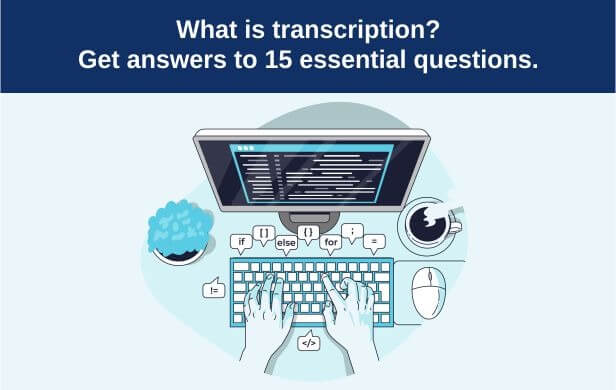
The word "Transcription" is derived from the Latin "trans," which means "across," and "scribere," which means "write." Transcription can be defined as the process of turning spoken speech into written text.
Depending on the nature of your work, Transcribing can help you and your company in various ways. For instance, well-placed transcribing can speed up work processes, improve record keeping, increase social media shares, increase accessibility, improve SEO and search discoverability of your audio and visual information, and more. In essence, Transcription eliminates the burden of inaccurate note-taking and unreliable memory, allowing for the permanent recording of every aspect of a speech or interview in an extremely adaptable format.
Every sound and silent moment is recorded in a precise transcription. This means that verbatim transcription captures every pause, repetition, phone ring, slammed door, cough, interruption, and "er... um... yeah... you know" in addition to speech.
The non-speech components of the transcription are ignored by an intelligent verbatim transcription, yet it accurately captures what was spoken. Intelligent verbatim transcription is useful when transcribing medical diagnoses or business presentations, amongst other applications.
A variation of intelligent verbatim transcription, known as an edited transcription, has any grammatical errors or incomplete phrases "tidied up" to make the language more intelligible. Edited transcription addresses issues like grammatical mistakes, slang, and incomplete sentences.
Instead of employing the actual words themselves, phonetic transcription records the sounds of the words using a set of symbols that is universally recognized. A phonetic transcription might be helpful when pronunciation matters, such as when comparing speech among various age groups, places, or eras.
Orthographic transcription concentrates on the words, not how they are spoken. Orthographic transcription is frequently used for extensive corporate events and documents, especially for research where pronunciation is unimportant.
Legal transcription is the process of turning audio and video recordings into written legal documents. Interviews that are admissible in court, statements made by witnesses, and routine courtroom activity can all be recorded.
Spoken content originating from a wide range of video and audio media is frequently transcribed into text document to facilitate editing and the distribution of the content to various media channels.
Students and researchers use transcription to convert interviews, lectures and seminars into text documents that are easy to search and edit. Transcription is also used by educational organizations to improve the quality and accessibility of teaching.
Interviews are at the heart of the work of a journalist or reporter. This ongoing flow of information needs to be absorbed, understood, and collated. Interview transcription provides the perfect solution, giving the journalist all the information in a clear, searchable, and editable format.
Other kinds of interviews also benefit from transcription. Job interviews, for example, where a written transcript allows a more objective appraisal to be made of what was said, free from the distraction of the interviewee’s appearance and body language.
Gathering and analysing non-numerical data, such as conversations with individuals and focus groups, is a common form of qualitative investigation used for market research. The researchers use transcriptions to keep an accurate, searchable record of what has been said about what, when and by whom. It also allows for the precise organization of data that gives researchers pinpoint accuracy.
Skilled human transcribers, such as courtroom stenographers and those dealing with highly sensitive material (such as evidence in ongoing investigations and interrogations), build their expertise over many years. As a result, they can deliver transcriptions at an extremely high standard. However, this expertise comes at a cost in terms of time and money, making manual transcription unsuitable for large-scale projects requiring a fast turnaround.
Recent advances in Artificial Intelligence (AI) have brought an extensive selection of technological speech-to-text solutions to the market. Indeed, transcription is almost becoming a standard feature of many operating systems and devices. From built-in features for Mac and PC users to cloud-based apps on mobile phones, automated transcription significantly reduces time and costs by using software to perform the task.
Automatic transcription does not (yet) meet the skill level of the trained human transcriber. It is necessary, therefore, to proofread anything that you choose to transcribe by artificial intelligence.
Businesses and organizations use transcription services for many reasons (some of which have been mentioned earlier in this article). Whether you require a manual or an automatic transcription service will depend on the sensitivity of your content, the accuracy required, and time and budget constraints. Transcription services typically offer the option of getting the best of both worlds by using AI to do 90% of the work at speed, followed by a human to identify and correct the errors that machine algorithms cannot detect. If you’re ready to start your transcription project, you must work with a transcription service provider you can trust. Language Services Bureau has the experience and expertise to navigate you through the complexities of the entire transcription process.
For any queries related to language translation services. Inquire at our email address below or give us a call today!
info@languageservicesbureau.com
Telephone: +91-20-24470509, +91-82370 60559
Similar articles for you...

आमच्या गेल्या महिन्यातील ब्लॉग मध्ये भाषांचे ज्ञान आवश्यक असणाऱ्या करियर क्षेत्रांची माहिती आपल्याला मिळाली. जिथे भाषेचे ज्ञान फायद्याचे ठरते असे इतर व्यवसाय आपण या महिन्यात पाहुयात.

Posted by : Language Services Bureau

The time it takes to learn a language depends on what you want to do with it– here is a great article about language learning and the kind of expectations you can set about the time required for the same!